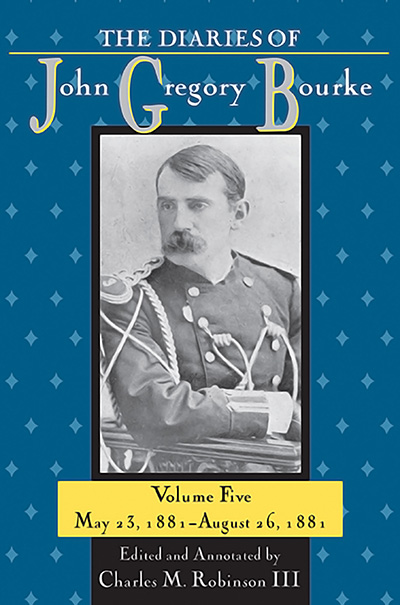
October, 2013
Published
560
Pages
71 b&w photos. 4 maps. App.
Features
About Robinson III's The Diaries of John Gregory Bourke Volume 5
John Gregory Bourke kept a monumental set of diaries beginning as a young cavalry lieutenant in Arizona in 1872, and ending the evening before his death in 1896. As aide-de-camp to Brigadier General George Crook, he had an insider’s view of the early Apache campaigns, the Great Sioux War, the Cheyenne Outbreak, and the Geronimo War. Bourke’s writings reveal much about military life on the western frontier, but he also was a noted ethnologist, writing extensive descriptions of American Indian civilization and illustrating his diaries with sketches and photographs.
Previously, researchers could consult only a small part of Bourke’s diary material in various publications, or else take a research trip to the archive and microfilm housed at West Point. Now, for the first time, the 124 manuscript volumes of the Bourke diaries are being compiled, edited, and annotated by Charles M. Robinson III in an easily accessible form to the modern researcher.
This fifth volume opens at Fort Wingate as Bourke prepares to visit the Navajos. Next, at the Pine River Agency, he is witness to the Sun Dance, where despite his discomfort at what he saw, he noted that during the Sun Dance piles of food and clothing were contributed by the Indians themselves, to relieve the poor among their people. Bourke continued his travels among the Zunis, the Rio Grande pueblos, and finally, with the Hopis to attend the Hopi Snake dance. The volume concludes at Fort Apache, Arizona, which is stirring with excitement over the activities of the Apache medicine man, Nakai’-dokli’ni, which Bourke spelled Na Kay do Klinni. This would erupt into bloodshed less than a week later.
Volume Five is especially important because it is the first in this series to deal almost exclusively with Bourke’s ethnological research. Aside from a brief trip to the East Coast, most of the text involves his observations either during the Great Oglala Sun Dance of 1881, or among the pueblos of New Mexico and Arizona. Bourke’s account of the Sun Dance is particularly significant because it was the last one held by the Oglalas. The Hopi material in this volume served as the basis of The Snake Dance of the Moquis of Arizona, published three years later in 1884, and perhaps his best-known work after On the Border with Crook.
Extensively annotated and with a biographical appendix on Indians, civilians, and military personnel named in the diaries, this book will appeal to western and military historians, students of American Indian life and culture, and to anyone interested in the development of the American West.
Praise for the series:
“The Bourke diaries are of great significance to the fields of Western American history and of Native American Studies. They are an unparalleled source on the internal operations of the Indian-fighting army and on ethnohistorical information on the tribes that Bourke came to know.” —Joseph Porter, author of Paper Medicine Man
“Robinson merits high praise for the herculean task of transcribing the entire diaries and remaining as faithful to the original text as possible. Publication of the series will be extremely useful for scholars of western America.” —Robert Wooster, author of The Military and United States Indian Policy 1865-1903
“The availability of the complete Bourke diaries, effectively presented and enhanced by Robinson’s introductory remarks, footnotes, and appended materials, is a milestone contribution to the field of western history and Indian wars research.” —Jerome A. Greene, author of Battles and Skirmishes of the Great Sioux War
“This is a must for the library of everyone interested in the Indians and the military frontier.” —Paul A. Hutton, author of Phil Sheridan and His Army
“Robinson’s Bourke volumes are definitive and the worth of the effort and material ranks at the highest of achievements. Bourke’s writings are keenly insightful, filled with color, and replete with a Who’s Who of the American West and Old Army.” —Paul L. Hedren, author of Fort Laramie and the Great Sioux War
“The University of North Texas Press deserves the thanks of all those interested in the North American Indian wars for undertaking the publication of this invaluable primary source.” —Journal of Military History
About the Editor
CHARLES M. ROBINSON III received his bachelor’s degree from St. Edward’s University and master’s from the University of Texas-Pan American, and was a history instructor at South Texas Community College. He wrote more than twelve books, including Bad Hand: A Biography of General Ranald S. Mackenzie (T.R. Fehrenbach Award) and The Court Martial of Lieutenant Henry Flipper (Spur Award finalist). Robinson appeared on television documentaries for the Public Broadcasting System and the History Channel.
Buy Now
The Diaries of John Gregory Bourke Volume 5: May 23, 1881–August 26, 1881
560 pp. 71 b&w photos. 4 maps. App.